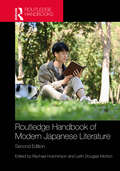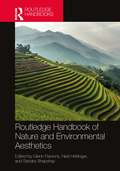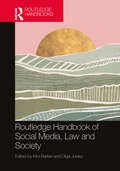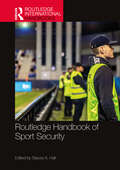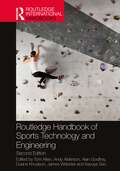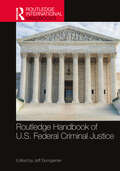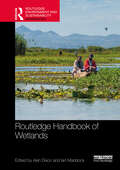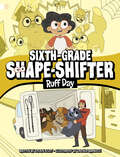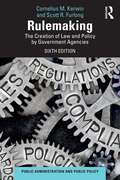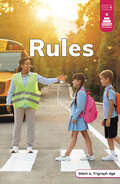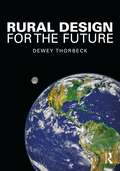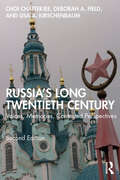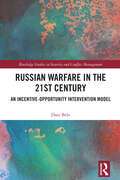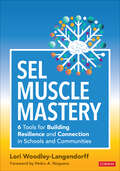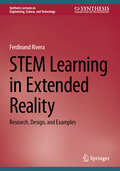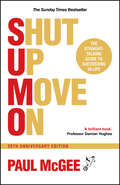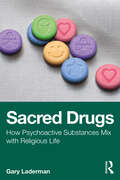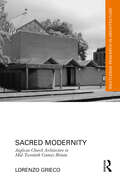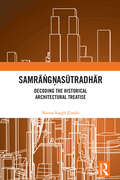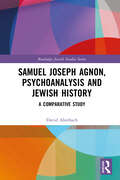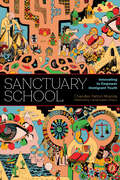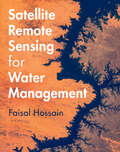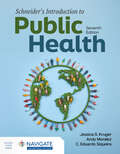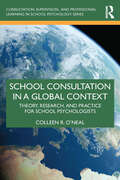- Table View
- List View
Routledge Handbook of Modern Japanese Literature
by Rachael Hutchinson and Leith MortonThis 2nd edition of the Routledge Handbook of Modern Japanese Literature provides a comprehensive survey of the field of modern Japanese literature and gives readers an overview of how we study Japanese literature today.Including sections on space and time, gender and sexuality, politics, war memory, national and colonial identities, and the production and dissemination of literature, the Handbook examines the ways in which it is possible to read modern Japanese literature and situate it in relation to critical theory. It also features updated and brand-new chapters addressing the works of internationally renowned writers such as Futabatei Shimei and Murakami Haruki and defines the way writers produce literature in modern Japan, as well as how those works have been read and understood by different readers in different time periods.Written by an international team of experts, the Handbook examines modes of literary production such as fiction, poetry, and critical essays as distinct forms of expression that nonetheless are closely interrelated and as such it will be a vital resource for students and scholars of Japanese Literature, literature in translation, and modern and contemporary literature.
Routledge Handbook of Nature and Environmental Aesthetics
by Sandra Shapshay Glenn Parsons Ned HettingerThis handbook provides the first comprehensive overview of philosophical thinking about the aesthetics of the natural and human-made environments, exploring the topic's foundations, key ideas, and current debates.Throughout history and across cultures, people's perceptions of beauty and ugliness in their surroundings have been an important part of the human experience. This volume contains more than 30 contributions from leading scholars examining environmental appreciation from a variety of perspectives. Chapters cover a wide range of environments and issues, including the aesthetics of animals, natural sounds, gardens, the urban environment, and the relation between aesthetics and environmentalism. It also explores new topics such as the appreciation of nature in ancient thought, love of place, the traditional nature aesthetics of China and Japan, and the aesthetics of climate change.The Routledge Handbook of Nature and Environmental Aesthetics will be essential reading for students and scholars working on the aesthetics of environment, as well as anyone who wants to think deeply about environmental beauty. Scholars working in related fields outside academic philosophy, such as geography, landscape studies, environmental psychology, and environmental studies will also find it an invaluable guide to contemporary debates.
Routledge Handbook of Social Media, Law and Society (Routledge Handbooks in Law)
by Kim Barker Olga JuraszThe Routledge Handbook of Social Media, Law and Society provides an international survey of social media and the law in society, blending academic, non-academic and non-governmental expertise to provide a thematic overview of social media and the law across a number of jurisdictions.Offering an international thematic view which examines social media and the law in the context of international research, the book addresses such topics as politics and social media, online safety developments and digital constitutionalism amongst a range of others. With contributions from experts across disciplines, the book is a topical contribution to the field, detailing online harms, fake news, misinformation and disinformation, hate speech and gender-based violence on social media. Additionally, the book covers social media, elections and electoral violence, feminist perspectives on social media, alongside children and social media, online safety, and responsibility and liability.Providing an analysis of the full spectrum of current issues in social media and the law, the Routledge Handbook of Social Media, Law and Society is an essential resource for advanced students, researchers, academics and industry experts.
Routledge Handbook of Sport Security (Routledge International Handbooks)
by Stacey A. HallThis book provides an in-depth analysis of security issues and concerns in contemporary sport. Featuring the work of leading researchers and practitioners from around the world, it offers practical, evidence-based commentary and guidance.Drawing on the latest research evidence, the book examines the multiple stakeholders, agencies, and organizations involved in providing a safe space for spectators, participants, staff, organizations, communities, and sponsors. It considers the coordination of private and public entities in the sports security ecosystem, including facility management, event management, law enforcement, emergency management, emergency medical services, and state/federal government partners, as well as the private sector organizations providing support services. The book also offers a comprehensive analysis of key issues and debates in contemporary sport security, including terrorism, cybersecurity, spectator violence, planning and assessment guidance for sport venues and events of all sizes, management and policy considerations for leaders and decision-makers, and the lessons learned from critical incidents. It introduces the core principles of research methods in sport security and looks ahead at future developments in this rapidly changing field.This is essential reading for any advanced student, researcher, practitioner, or policy-maker with an interest in sport studies, security studies, event studies, criminal justice, management, or public policy.
Routledge Handbook of Sports Technology and Engineering (Routledge International Handbooks)
by James Webster Tom Allen Duane Knudson Alan Godfrey Andy Alderson Kazuya SeoSince the 1990s, the field of sports technology and engineering has expanded beyond an initial focus on sports equipment and materials to include various topics. These topics span sustainable equipment design and manufacturing, user‑centred design, biomechanics and human‑equipment interaction, field testing, sensors and instrumentation of sports equipment and clothing, smart textiles, artificial intelligence and big data, and the development of human body surrogates for testing protective equipment. This second edition of Routledge Handbook of Sports Technology and Engineering pulls together the full depth and breadth of this field, explores current issues and controversies, and looks to future research directions. Bringing together many of the world’s leading experts and scientists, this book emphasises the current understanding of the underlying mechanics associated with sport and physical activity, exercise, training, and athletic performance in relation to sports equipment, clothing, and training and officiating technologies in a broad sense.This book has five sections: Sports mechanics Sports materials Sports equipment design and manufacture Sports biomechanics and human‑equipment interaction Field testing, sensors, and instrumentation Written by an international team of leading experts, the emphasis throughout this book is on bridging the gap between scientific research and application within sports products and their effect on training and competition. This text is important reading for students, scholars, and others with an interest in engineering related to sport, exercise, and health in general.
Routledge Handbook of U.S. Federal Criminal Justice (Routledge International Handbooks)
by Jeff BumgarnerThis collection provides readers with a comprehensive overview of the American federal criminal justice system. The book unites theoretical notions and advancements in practice, and brings a full picture of the U.S. federal criminal justice system into focus. The chapters are arranged in a logical sequence, with readers first being introduced to the federal criminal justice system and given an overview of federal law enforcement, the most visible and storied sector of federal criminal justice. The introductory chapters are followed by more detailed explorations of federal law enforcement, federal corrections, the federal judiciary and legal processes, and contemporary issues.This handbook is essential reading and an authoritative reference for scholars, students, researchers and practitioners of criminal justice, criminology, public policy, and public administration. It is also ideal for use as a text in introductory and advanced survey courses on criminal justice or courses on crime policy.
Routledge Handbook of Wetlands (Routledge Environment and Sustainability Handbooks)
by Ian Maddock Alan DixonThis handbook provides a comprehensive and interdisciplinary overview of the place, value and significance of wetlands, presenting perspectives from across the environmental and social sciences.Recent decades have witnessed unprecedented global interest in wetlands and the critical role they play in supporting biodiversity and ecosystem services such as carbon storage, flood mitigation, as well as their direct benefits for people and society that include the provision of food, clean water and a range of cultural services. This Routledge Handbook of Wetlands brings together a wide range of perspectives from social and environmental disciplines, and voices from different wetland stakeholders from the global north and south, to present an assessment of our current understanding of wetlands, their environmental significance, and their place in society and policy. A recurring theme of the book is an exploration of how our current knowledge of wetlands, that is often fragmented along traditional disciplinary lines, can be brought together to enable a more integrated, interdisciplinary and social-ecological conceptualisation that aligns more closely with real-world complex challenges, and which offers new directions in wetland management for sustainable development.This handbook will be essential reading for students and scholars of wetland management, environmental science, water resource management, conservation ecology, environmental humanities and sustainable development.
Ruff Day
by Steven ScottSawyer’s plan to help his sister Stacey conquer her fear of spiders backfires when he shape-shifts into one—only to get chased by the family cat and nearly squashed! Things get even wilder when he turns into a dog and is mistaken for a stray. Captured by the dogcatcher, Sawyer must think fast (and shift even faster) to free himself and a group of caged pups. Can Sawyer use his powers to save the day, or is he stuck in the doghouse for good? With hilarious twists, vibrant illustrations, and plenty of action, this graphic novel is perfect for reluctant or struggling readers.
Rulemaking: The Creation of Law and Policy by Government Agencies (Public Administration and Public Policy)
by Scott R. Furlong Cornelius M. KerwinRulemaking refines, and in some instances defines, the mission of every government agency and affects the lives and activities of all citizens and often non-citizens. It provides directions and content for budgeting, program implementation, procurement, personnel management, dispute resolution, and other important government activities. In this substantially updated sixth edition, authors Kerwin and Furlong continue to offer the most comprehensive and accessible exploration of the most critical source of law and policy in the United States today. As they demonstrate, anyone interested in developing a sophisticated understanding of the operation of our political system or any aspect of the public policy process must develop a working knowledge of rulemaking. New to the sixth edition: New examples and case studies incorporated throughout the text, including a thorough examination of West Virginia v. EPA to introduce the concept of rulemaking New material that updates coverage of the Trump I and Biden presidencies, as well as the landmark Supreme Court decision in Loper Industries v. Raimondo that repudiates the Chevron Doctrine and calls for greater direction from Congress in delegations of rulemaking authority A significantly reformulated chapter on Measures of Rulemaking Success from a policy analysis perspective with discussion on efficiency, effectiveness, equity, and more. It also addresses expectations that various stakeholders have for rulemaking, including quality, volume, timeliness, effectiveness, efficiency, and equity Additional analysis of the use of alternatives to conventional rulemaking, including executive orders and related presidential communications and guidance documents of various sorts exploring the positive and negative effects of executive orders and presidential memoranda, guidance documents, technical corrections, and so-called “Dear Colleague” letters An entirely new chapter, Information, that focuses on the different forms of information agencies need to write rules. The categories include information on the law, policy, implementation, impact, public participation, and management. In addition to defining and distinguishing these types, the authors cover the sources agencies rely on to secure each type of information A significantly reformulated concluding chapter that continues to develop a theory of rulemaking and considers the influences on rulemaking and serious attempts at rulemaking reform from scholars, organizations, and institutions whose mission is the advancement of better government The breadth of the authors’ approach makes Rulemaking an essential primary text for advanced undergraduate and graduate courses on public policy, public administration, and political science. It also serves as an important supplementary text for related courses in schools of law and business.
Rules
by Laura StickneyThere are rules for driving cars, playing games, and even being at school. Beginning readers hone their phonics skills while learning about the importance of following rules in everyday life. As readers practice decoding words with silent e and the trigraph dge, they gain nonfiction knowledge. Every Stairway Decodables book combines multiple aspects of the Science of Reading to support small group instruction, independent reading, and reading practice at home.
Rural Design for the Future
by Dewey ThorbeckDesign thinking and the problem-solving process of design is a strategic resource. Through creativity, innovation, and entrepreneurship it can help communities optimize limited land and water resources in urban and rural landscapes. To address the problems facing communities, it connects human, animal and environmental health through design for both urban and rural regions.Rural Design for the Future provides a methodology for holistically crossing borders and connecting issues to nurture new design thinking and collaborative problem solving. It recognizes that human and natural systems are inextricably coupled and engaged in continuous cycles of mutual influence and response. It presents a process which provides an integrated system of human communities, plants and animals that meet the needs of people, the economy and the environment in the present, without compromising for the future. Following the author’s first book Rural Design, it discusses the development of community based rural design over the past decade, and expands on using the rural design process to cross national, state, county, township and city borders in order to make connections for better urban and rural futures for everyone.The book includes projects from around the world including many of the author’s sketches in black ink and watercolor of places that he and his wife have visited together. It will allow designers, architects, policymakers and citizens to envisage the solutions to some of the most pressing issues in rural design.
Russia's Long Twentieth Century: Voices, Memories, Contested Perspectives
by Choi Chatterjee Lisa A. Kirschenbaum Deborah A. FieldCovering the sweep of Russian history from empire to Soviet Union to post-Soviet state, this new edition of Russia's Long Twentieth Century is an accessible textbook that encourages students to start a lively conversation with Russia’s storied past.Chronologically organized, the book moves beyond the traditional Cold War framework, situating Russian history within world history. It covers topics including state power, political ideology, economic change, and foreign policy, highlighting the perspectives of “ordinary” people and exploring the impacts of race, ethnicity, nationality, gender, and generation on historical experience. Taking an inquiry-based approach, the authors show how scholars diverge sharply in their understanding of key events, historical processes, and personalities. Each chapter contains a selection of primary sources and discussion questions, engaging with the voices and experiences of diverse Soviet citizens and familiarizing students with the techniques of source criticism. The second edition features expanded coverage of the non-Russian regions of the Russian empire and the Soviet Union, adding new sections on Ukraine in particular. To help students navigate the book, the new edition also includes a timeline of key events and people, and a glossary.With a variety of learning tools, maps, and images, this volume is an essential introduction to twentieth-century Russian history.
Russian Warfare in the 21st Century: An Incentive-Opportunity Intervention Model (Routledge Studies in Security and Conflict Management)
by Dani BeloThis book provides a comprehensive analysis of Russia's foreign policy in gray zone conflicts, with a particular focus on its interventions in Ukraine.Challenging conventional views, the book contends that Russia's use of varied gray zone tactics is influenced by both system-level incentives and domestic-level opportunities, which are integrated here into the Incentive-Opportunity Intervention (IOI) Model. The book examines case studies including Abkhazia, Crimea, Odesa, Kharkiv, and the Donbas, demonstrating how local ethnic-based movements and perceptions of regional retreat shape Moscow's coercive strategies. It highlights the reactive nature of Russia's tactics, driven by perceived threats to its protector role, and the significant role of ethnic and political dynamics in the region. The study underscores the importance of understanding these motivations for effective conflict resolution and suggests that protecting minority rights could mitigate such interventions. Policy recommendations emphasize the need for nuanced approaches that address both geopolitical and local dynamics. Ultimately, the book calls for future research to apply the IOI Model to other great powers, enhance the generalizability and applicability of the findings, and highlight the potential for multilateral coordination in promoting minority rights as a strategy for conflict prevention.This book will be of much interest to students and policy practitioners working on Russian foreign policy, international security, Eastern European politics, and International Relations
SEL Muscle Mastery: Six Tools for Building Resilience and Connection in Schools and Communities
by Lori Woodley-LangendorffSocial emotional literacy is for everyone! Adults are tasked with teaching social emotional literacy (SEL), including skills like curiosity, respect, and problem-solving, but too often we fail to acknowledge or tend to our own well-being. In SEL Muscle Mastery, you will discover six SEL Muscles™ that, when strengthened and flexed with skill, support our own emotional balance and are key to building resilient and joyful environments where we can effectively teach and kids can sustainably learn. Inside this transformative guidebook, you′ll discover: A framework for managing student behavior and classroom dynamics, finding personal fulfillment, and supporting the whole child Reflection prompts for readers to use to consider what is present in the moment and what is possible in the future Links to videos and an open-access curriculum Exercises, stories, and examples for teachers, caregivers, and community members In this beautifully illustrated book, Lori Woodley-Langendorff, a former school counselor and award-winning film producer and educational consultant, presents a powerful new toolkit to enhance your ability to navigate difficult circumstances with greater ease and joy, both in and out of the classroom.
SEL Muscle Mastery: Six Tools for Building Resilience and Connection in Schools and Communities
by Lori Woodley-LangendorffSocial emotional literacy is for everyone! Adults are tasked with teaching social emotional literacy (SEL), including skills like curiosity, respect, and problem-solving, but too often we fail to acknowledge or tend to our own well-being. In SEL Muscle Mastery, you will discover six SEL Muscles™ that, when strengthened and flexed with skill, support our own emotional balance and are key to building resilient and joyful environments where we can effectively teach and kids can sustainably learn. Inside this transformative guidebook, you′ll discover: A framework for managing student behavior and classroom dynamics, finding personal fulfillment, and supporting the whole child Reflection prompts for readers to use to consider what is present in the moment and what is possible in the future Links to videos and an open-access curriculum Exercises, stories, and examples for teachers, caregivers, and community members In this beautifully illustrated book, Lori Woodley-Langendorff, a former school counselor and award-winning film producer and educational consultant, presents a powerful new toolkit to enhance your ability to navigate difficult circumstances with greater ease and joy, both in and out of the classroom.
STEM Learning in Extended Reality: Research, Design, and Examples (Synthesis Lectures on Engineering, Science, and Technology)
by Ferdinand RiveraThis book synthesizes findings from recent and ongoing research on the use of Extended Reality (XR) to support learning of STEM content. XR is slowly being introduced in classrooms due to significant changes in XR technology. These tools were historically costly, unfriendly, and developed only for gamers. Today, XR tools are able to enhance students’ immersive experiences in such settings. In classrooms, in particular, they provide learners with an opportunity to manipulate abstract objects as if they are physical objects. The book begins with an extensive and detailed description and evaluation of the impact of various XR interventions on learning and engagement in STEM classrooms. The author then concludes with theoretical frameworks for investigating learning in computer- immersive contexts and practical implications for effectively using XR tools to learn STEM.
SUMO (Shut Up, Move On): The Straight-Talking Guide to Succeeding in Life, 20th Anniversary Edition
by Paul McGee‘SUMO is a brilliant book, packed with simple, inspirational and innovative ideas that can be applied to any aspect of your life. Paul’s knowledge, enthusiasm and ability to clearly explain these methods is unsurpassed. I heartily recommend this excellent read.’ Professor Damian Hughes, Author and Co-Host of The High Performance Podcast ‘Paul offers a fresh, practical and down to earth approach to change and getting the best from life. An uplifting read for anyone looking to find their spark.’ Owen O'Kane, Psychotherapist & Sunday Times Best Selling Author Want some straight-talking advice on how to really improve your life? In the 20th Anniversary Edition of SUMO (Shut Up, Move On): The Straight-Talking Guide to Succeeding in Life, bestselling author and personal development heavyweight Paul McGee delivers inspiring insights by revealing how hundreds of thousands of people around the world are fulfilling their potential, seizing opportunities, succeeding at home and at work, and increasing their resilience by adopting the SUMO approach to life. McGee combines hard-won personal insights, ancient wisdom, modern science, hilarious anecdotes, practical tips, and hands-on frameworks to offer a life-changing read. New to this edition is an exploration of how real people have profoundly improved their lives with the book's timeless principles and strategies, providing a testament to the enduring power of the SUMO principles. You'll find: Exciting and inspirational advice for taking control of your own life Ways to change your thinking, mindset, and approach to life's inevitable obstacles Ideas to improve your understanding and awareness of the way that other people see the world Perfect for people wanting a straight-talking approach to success, as well as those who are already fans of the SUMO way of thinking, this new 20th Anniversary Edition is a must-have resource for everyone who's ready to ditch the “whatever will be, will be” fatalism in favor of a practical guide to being the best you can be and achieving what you've always dreamed about.
Sacred Drugs: How Psychoactive Substances Mix with Religious Life
by Gary LadermanSacred Drugs explores the numerous ways in which psychoactive substances, from alcohol to psilocybin, cannabis to pharmaceuticals, and coffee to tobacco, intersect with religious life. This cutting-edge volume acknowledges the ubiquity of drug use in American society and that, in fact, being drugged with an altered state of consciousness is a common feature of American life today, as it has been throughout human history and across global ancient cultures. Its focus is on the undeniable and pervasive evidence that drugs are often consumed for religious purposes.Sacred Drugs touches on the presence of drugs in a number of religious traditions, including Christianity, Hinduism, and Islam. It also delves into the religious textures, sensibilities, and histories of psychoactive agents, sometimes intersecting with these traditions, sometimes with Indigenous cultures around the world, and sometimes not directly related to any particular religion, but instead related to more basic existential religious concerns: a mortal body that suffers, ages, and dies, but also yearns for transcendence, healing, and ecstasy; or the desire to uncover and live true to one's identity, as well as to find energizing communities that bind individuals together; or how to counter chaos, meaninglessness, and disorder. This controversial book will be the go-to volume for readers interested in the complex relationship between religious life and psychoactive substances.
Sacred Modernity: Anglican Church Architecture in Mid-Twentieth Century Britain (Routledge Research in Architecture)
by Lorenzo GriecoThis book examines mid-20th-century Anglican church architecture in Britain, from the 1935 to the 1975, exploring how it was shaped by liturgical changes, social shifts, and artistic influences. It investigates the theoretical foundations of modern Anglican church design and the contributions of various denominations to shared worship spaces.Amidst the rise of research groups, publications, and photographic documentation, the book highlights the subject’s significance in this period. Inspired by the liturgical reformation within the Church of England, it analyzes churches in their urban contexts and the communities they served, revealing the complex interplay between architects, engineers, artists, local authorities, and clergy.The book also addresses post-war church reconstruction, the adaptation of existing buildings, and the integration of new construction technologies. It explores how churches accommodated secular functions alongside sacred spaces to reduce maintenance costs and foster communal identity. As secularization grew—particularly affecting the Church of England—it also considers the transformation of redundant churches into secular venues.Adopting a cross-disciplinary approach, the book situates Anglican church architecture within broader religious, urban, and social contexts, offering a comprehensive perspective for scholars and practitioners alike.
Samrāṅgṇasūtradhār: Decoding the Historical Architectural Treatise
by Neena Singh ZutshiThe Samrāṅgṇasūtradhār compiled arounf the 11th century by Rājā Bhoj is a significant treatise on architecture from pre-colonial India. The book presents and interpretive architectural analysis of select content of the Samrāṅgṇasūtradhār,explores the design process to generate temples, palaces, and dwelling units, and discusses its correlation with contemporary architectural paradigms. Also, the book looks at contemporary issues of identity and culture, as well as critical issues int he historiography of architecture in the postcolonial Indian subcontinent while unveiling layers of the traditional knowekedge systems informing the popular idiom of the Vāstū Shastra. Strongly rooted in archival resources, this book will be indispensable for scholars of history of Indian architecture, heritage studies, South Asian history, conversation, architectural design processes, compuational architecture, and postcolonial studies.
Samuel Joseph Agnon, Psychoanalysis and Jewish History: A Comparative Study (Routledge Jewish Studies Series)
by David AberbachSamuel Joseph Agnon, Psychoanalysis and Jewish History: A Comparative Study compares the writings of Samuel Joseph Agnon (1887–1970) with other writers, including Gustav Flaubert, Franz Kafka, D.H. Lawrence, and Carl Gustav Jung, as well as his great Hebrew predecessors, Mendele Mocher Sefraim and Chaim Nachman Bialik, who drew on the ancient Jewish biblical and rabbinic tradition in creating a modern secular literature.Through close readings of Agnon’s fiction in comparison with some of his great contemporaries, the reader comes to a new appreciation of the richness and psychological depth of modern Hebrew literary art and its roots in ancient Jewish history and literature; of Agnon as a major figure bridging the traditional culture of the pre-1939 East European Jews with the modern world; of Hebrew fiction amid tumultuous historical change, as its centre shifted in the early 20th century from Eastern Europe to Tel Aviv; and of the centrality of Hebrew literature in the rise of modern Jewish nationalism as anti-Semitism grew.This book is of particular value to students of Hebrew and Comparative Literature and of psychoanalysis and the sociology of literature, but it is written clearly and without jargon and has much interest to the general reader.
Sanctuary School: Innovating to Empower Immigrant Youth
by Chandler Patton MirandaA compassionate examination of a topic of urgent concern in US education
Satellite Remote Sensing for Water Management
by Faisal HossainThis textbook reflects the changing landscape of water management by combining the fields of satellite remote sensing and water management. Divided into three major sections, it begins by discussing the information that satellite remote sensing can provide about water, and then moves on to examine how it can address real-world management challenges, focusing on precipitation, surface water, irrigation management, reservoir monitoring, and water temperature tracking. The final part analyses governance and social issues that have recently been given more attention as the world reckons with social justice and equity aspects of engineering solutions. This book uses case studies from around the globe to demonstrate how satellite remote sensing can improve traditional water practices and includes end-of-chapter exercises to facilitate student learning. It is intended for advanced undergraduate and graduate students in water resource management, and as reference textbook for researchers and professionals.
Schneider's Introduction to Public Health with Navigate Advantage Access
by Jessica Kruger Andy Moralez C. Eduardo SiqueiraOffering a thorough, accessible and lively overview of public health for students new to the field, Schneider’s Introduction to Public Health offers a broad-reaching, practical framework for understanding the forces and organizations of public health today. Through engaging, nontechnical language, illustrative real-world examples, and the current political, economic, and cultural news of the day, students gain a clear understanding of the scope of today's public health problems and possible solutions. Building on Mary-Jane Schneider’s engaging and easy-to-read narrative approach, new author team Kruger, Moralez, and Siqueira draw on their diverse perspectives for the Seventh Edition to bring a greater focus on the social determinants of health, ecological approach, and life course experiences as a framework to understand public health in the 21st century.
School Consultation in a Global Context: Theory, Research, and Practice for School Psychologists (Consultation, Supervision, and Professional Learning in School Psychology Series)
by Colleen R. O'NealSchool Consultation in a Global Context provides theoretical foundations, empirical research, lessons learned, and implications for practice in school consultation across distinct cultures and national borders. School psychologists have new opportunities to leverage existing and innovative frameworks, research methods, and advocacy supports to provide effective service for culturally diverse populations globally, including refugees. Driven by liberatory, participant-centered interventions and research designs, this book is an essential resource for building long-term global school consultation partnerships and reaching successful outcomes. School psychology researchers and practitioners will be well-prepared by this collaborative approach to global school consultation partnership development, training, intervention implementation and evaluation, tele-consultation, grant funding, theories, formative and effectiveness research, and more across international contexts.
